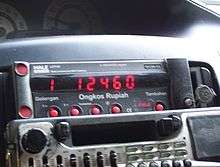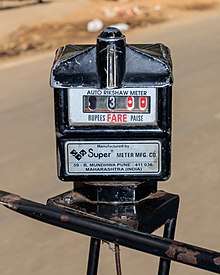Taximeter
A taximeter is a mechanical or electronic device installed in taxicabs and auto rickshaws that calculates passenger fares based on a combination of distance travelled and waiting time. Its shortened form, "taxi", is also a metonym for the hired cars that use them.[1][2]
.png)

History

The modern taximeter was invented by German Friedrich Wilhelm Gustav Bruhn in 1891,[3] and the Daimler Victoria—the world's first meter-equipped (and gasoline-powered) taxicab—was built by Gottlieb Daimler in 1897.
Taximeters were originally mechanical and mounted outside the cab, above the driver's side front wheel. Meters were soon relocated inside the taxi, and in the 1980s electronic meters were introduced, doing away with the once-familiar ticking sound of the meter's timing mechanism.
In some locations, taxicabs display a small illuminated sign indicating if they are free (available). In Argentina, this sign is called a "banderita" (little flag), a carryover term from the days of mechanical taximeters, in which a little flag was turned to wind up the mechanism. The flag would be hidden at the start of a trip and moved to the visible position at the end.
World Moto developed the world's first portable taximeter for motorcycles and pedicabs, which Fast Company called "the First Real Taxi Meter Innovation in 100 Years".[4]
Accessories and features

Taximeters can include several accessories, or act as components in larger dispatching/control systems. Features include:
- Ticket/receipt printer
- Fraud control and prevention (on the part of the owner or operator), through the impression of control tickets or computer monitoring. Additionally, taximeters are often visually sealed by a municipal weights and scales authority after initial calibration.
- Radio communication, allowing trip status to be monitored by a dispatcher or supervisor.
- Dispatching of trip assignments through radio or data systems.
- Interaction with GPS systems to assist with dispatching and to provide security.
- Seat sensors that detect the presence of a passenger (to prevent a cab from carrying fares without activating the taximeter).
- Credit or prepaid card support.
- Bluetooth support for communication with smartphones or tablets.
- USB support for setup, diagnostics, and connectivity to the vehicle computer.
Work cycle
During normal operation, taximeters repeat cyclically through several stages:
- Free (or For Hire in the UK): The taxicab is empty and available for hire. The luminous sign, if present, is switched on.
- Occupied (or Hired): The taximeter enters in this stage at the start of the trip and the "Free" sign is switched off. In this stage the running fare and the present tariff are displayed. Additional information that can be displayed in this mode includes extras (e.g. credits for luggage), present time, speed, etc.
- To Pay (or Stopped in the UK): At the end of the trip, the driver enters this stage to collect payment, make change, and optionally print a receipt. The exterior roof light may also blink to alert potential passengers that the taxi will soon be available.
References
- "taximeter" (Fourth ed.). The American Heritage Dictionary of the English Language (Bartleby). 2000. Archived from the original on 12 July 2001. Retrieved 22 April 2015.
- Fierro, Alfred, Histoire et Dictionnaire de Paris (1996), Robert Laffont, page 1166, ISBN 2-221-07862-4
- McArdle, Megan (2012-05-01). "Why You Can't Get a Taxi". The Atlantic. Retrieved 2015-10-02.
- Zax, David (2011-02-08). "Introducing the First Real Taxi Meter Innovation in 100 Years". Fast Company. Retrieved 2015-10-02.
| Wikimedia Commons has media related to Taximeters. |
| Look up taximeter in Wiktionary, the free dictionary. |